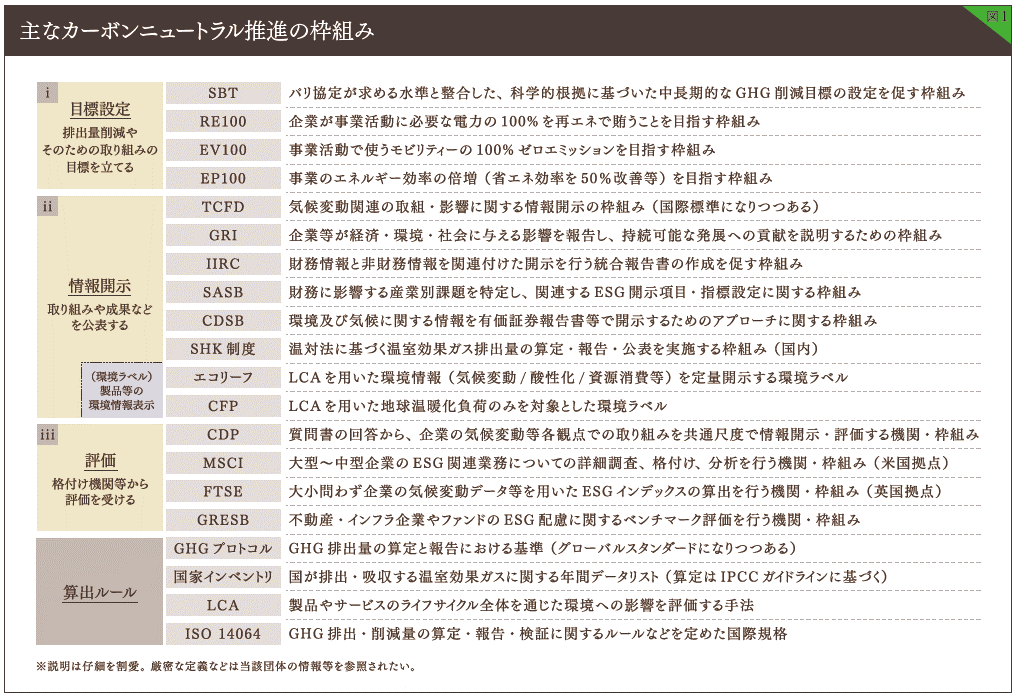Understanding and Leveraging Frameworks to Accelerate Carbon Neutrality

Four Points to Remember About the Framework
Currently, achieving decarbonized management is one of the most critical management themes for all companies aiming to reach carbon neutrality (CN). Since the Paris Agreement, frameworks and standards to promote CN efforts have been developed and disseminated, primarily through international initiatives. These frameworks support and promote the disclosure of management strategies addressing climate change and the setting of goals for reducing CO2 and other emissions. Additionally, corporate information and ratings disclosed through these frameworks have become crucial decision-making factors for international ESG investment. In other words, as all companies are compelled to promote decarbonized management, how these frameworks are utilized will significantly impact their future. Will this global CN trend become an "opportunity" to differentiate from competitors and secure investment and business prospects, or will it pose a "threat" by causing companies to lag behind market standards and be forced into reactive measures?
In consulting engagements, it is apparent that clients often face challenges with the frameworks. The level of understanding and utilization of these frameworks varies across companies and even among departments within a single company. Specific issues and questions arise based on the degree of understanding and enthusiasm.
The initial question typically is, "What frameworks exist in the first place?" Although fewer companies and employees are at this basic stage now, there is often vague understanding of the types of frameworks, and perceptions may differ among individuals.
As understanding deepens, issues such as, "While individual frameworks are understood, a comprehensive view is lacking. Where should we start?" often emerge. This situation frequently arises when the relationships and priorities among frameworks are not clearly grasped in an overall context.
Once a comprehensive view of the frameworks is established, issues regarding specific responses and initiatives become clearer. These include "How should we structure our internal systems to comply with the framework?" and "What specific CO2 reduction measures should we plan and implement?" For instance, if there are multiple sites, who will measure, calculate, and report CO2 emissions, when, and how? What actions should be taken to achieve the goals set by each framework?
This paper summarizes four key points regarding the framework in response to the aforementioned issues and questions. These points will be explained in order.
Discussion Point ❶: Types of Frameworks
What types of frameworks are there?
Discussion Point ❷: Relationships Between Frameworks
What are the relationships among the frameworks?
Discussion Point ❸: Priority of Frameworks
Which frameworks should be prioritized?
Discussion Point ❹: Responses and Initiatives to Frameworks
How should we develop systems to comply with the frameworks, and what specific CN measures should be planned and implemented?
❶ Types of Frameworks
■ Identify the three types: "goal setting," "information disclosure," and "evaluation"
There are three main types of frameworks for promoting CN: "i. Goal setting," which involves establishing targets for emissions reduction and related efforts; "ii. Information disclosure," which involves publicizing efforts and results to foster dialogue between companies and investors or financial institutions; and "iii. Evaluation," conducted by rating agencies and other organizations based on the disclosed information. Additionally, there are "calculation rules" for emissions that underpin these frameworks. The most representative ones are shown in Figure 1. Let’s review them in order.
Firstly, "i. Goal setting" refers to the standards required by the Paris Agreement...

To read the full text, please download the PDF.
DownloadPDF(1.41 MB)